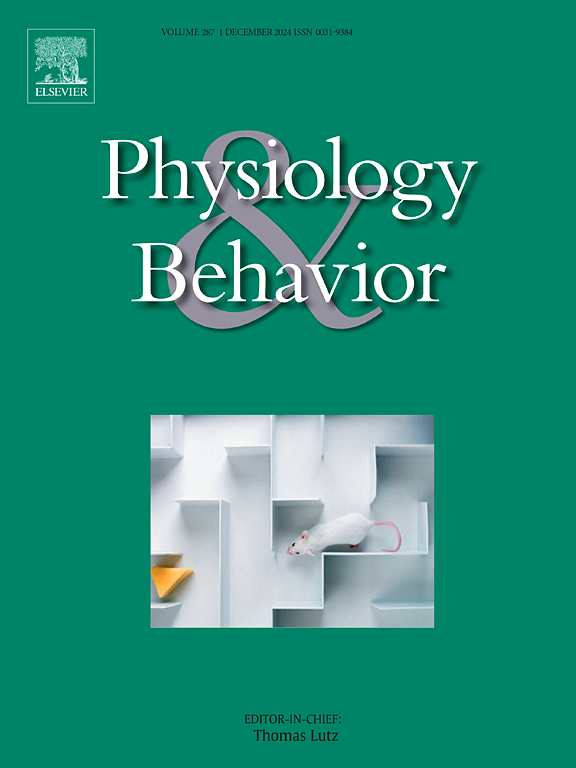Central pramlintide administration potently suppresses operant responding for sucrose and locomotor activity in male rats
IF 2.5
3区 医学
Q2 BEHAVIORAL SCIENCES
引用次数: 0
Abstract
Amylin is a feeding-suppressive hormone which acts centrally in the control of energy balance. Some evidence suggests it reduces motivation for food rewards. Pramlintide is a synthetic amylin analog that is used clinically in the treatment of diabetes, and it also reduces feeding and weight gain. However, the mechanisms behind these pramlintide-induced reductions in feeding are unclear. Here we tested the hypothesis that pramlintide would decrease motivation for a palatable food, sucrose pellets. Results show that peripheral (IP) pramlintide had no effect on progressive ratio responding for sucrose pellets. In contrast, intracerebroventricular (ICV) pramlintide reduced active lever pressing, reinforcers earned, and breakpoint for sucrose, even at lower doses subthreshold for effects on 24 h chow intake and body weight change. However, lever pressing behavior was completely abolished for many rats, raising concern for unexpected motor effects. To test whether central pramlintide impacted locomotor activity, we conducted an open field study and found that ICV pramlintide significantly reduced distance traveled at several timepoints, suggesting suppressed locomotor activity. Overall, our results suggest that peripheral pramlintide does not affect motivation for sucrose, and that although central pramlintide does reduce outcomes assessing motivation, this may be confounded by a concurrent reduction in locomotor activity.
中央普兰林肽给药可有效抑制雄性大鼠对蔗糖和运动活动的操作性反应。
胰淀素是一种摄食抑制激素,在能量平衡控制中起中心作用。一些证据表明,它会降低食物奖励的动机。普兰林肽是一种合成的胰淀素类似物,在临床上用于治疗糖尿病,它还可以减少喂养和体重增加。然而,普兰林肽引起的喂养减少背后的机制尚不清楚。在这里,我们测试了一个假设,即普兰林肽会降低对美味食物——蔗糖粒的动力。结果表明,外周普兰林肽对蔗糖微球的递进率响应没有影响。相比之下,脑室内(ICV)普兰林肽降低了活性杠杆压力、获得的强化物和蔗糖的断点,即使在较低剂量下,对24小时饲料摄入量和体重变化的影响也低于阈值。然而,许多大鼠完全取消了杠杆按压行为,引起了对意外运动效应的关注。为了测试中央普兰林肽是否影响运动活动,我们进行了一项开放的实地研究,发现ICV普兰林肽在几个时间点显著缩短了运动距离,表明运动活动受到抑制。总的来说,我们的结果表明,外周普兰林肽不影响蔗糖的动机,尽管中央普兰林肽确实降低了评估动机的结果,但这可能与运动活动的同时减少相混淆。
本文章由计算机程序翻译,如有差异,请以英文原文为准。
求助全文
约1分钟内获得全文
求助全文
来源期刊

Physiology & Behavior
医学-行为科学
CiteScore
5.70
自引率
3.40%
发文量
274
审稿时长
47 days
期刊介绍:
Physiology & Behavior is aimed at the causal physiological mechanisms of behavior and its modulation by environmental factors. The journal invites original reports in the broad area of behavioral and cognitive neuroscience, in which at least one variable is physiological and the primary emphasis and theoretical context are behavioral. The range of subjects includes behavioral neuroendocrinology, psychoneuroimmunology, learning and memory, ingestion, social behavior, and studies related to the mechanisms of psychopathology. Contemporary reviews and theoretical articles are welcomed and the Editors invite such proposals from interested authors.
 求助内容:
求助内容: 应助结果提醒方式:
应助结果提醒方式:


